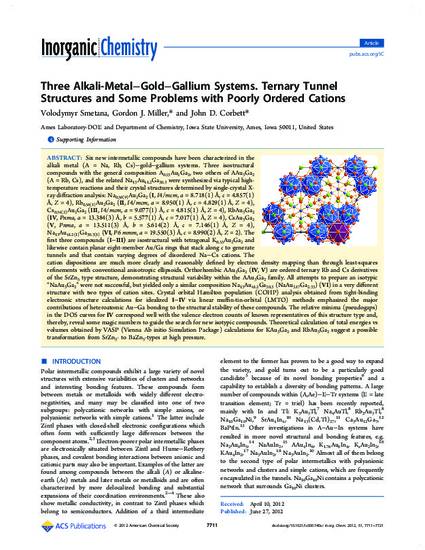
Six new intermetallic compounds have been characterized in the alkali metal (A = Na, Rb, Cs)–gold–gallium systems. Three isostructural compounds with the general composition A0.55Au2Ga2, two others of AAu3Ga2 (A = Rb, Cs), and the related Na13Au41.2Ga30.3 were synthesized via typical high-temperature reactions and their crystal structures determined by single-crystal X-ray diffraction analysis: Na0.56(9)Au2Ga2 (I, I4/mcm, a = 8.718(1) Å, c = 4.857(1) Å, Z = 4), Rb0.56(1)Au2Ga2 (II, I4/mcm, a = 8.950(1) Å, c = 4.829(1) Å, Z = 4), Cs0.54(2)Au2Ga2 (III, I4/mcm, a = 9.077(1) Å, c = 4.815(1) Å, Z = 4), RbAu3Ga2 (IV, Pnma, a = 13.384(3) Å, b = 5.577(1) Å, c = 7.017(1) Å, Z = 4), CsAu3Ga2 (V, Pnma, a = 13.511(3) Å, b = 5.614(2) Å, c = 7.146(1) Å, Z = 4), Na13Au41.2(1)Ga30.3(1) (VI, P6 mmm, a = 19.550(3) Å, c = 8.990(2) Å, Z = 2). The first three compounds (I–III) are isostructural with tetragonal K0.55Au2Ga2 and likewise contain planar eight-member Au/Ga rings that stack along c to generate tunnels and that contain varying degrees of disordered Na–Cs cations. The cation dispositions are much more clearly and reasonably defined by electron density mapping than through least-squares refinements with conventional anisotropic ellipsoids. Orthorhombic AAu3Ga2 (IV, V) are ordered ternary Rb and Cs derivatives of the SrZn5 type structure, demonstrating structural variability within the AAu3Ga2 family. All attempts to prepare an isotypic “NaAu3Ga2” were not successful, but yielded only a similar composition Na13Au41.2Ga30.3 (NaAu3.17Ga2.33) (VI) in a very different structure with two types of cation sites. Crystal orbital Hamilton population (COHP) analysis obtained from tight-binding electronic structure calculations for idealized I–IV via linear muffin-tin-orbital (LMTO) methods emphasized the major contributions of heteroatomic Au–Ga bonding to the structural stability of these compounds. The relative minima (pseudogaps) in the DOS curves for IV correspond well with the valence electron counts of known representatives of this structure type and, thereby, reveal some magic numbers to guide the search for new isotypic compounds. Theoretical calculation of total energies vs volumes obtained by VASP (Vienna Ab initio Simulation Package) calculations for KAu3Ga2 and RbAu3Ga2 suggest a possible transformation from SrZn5- to BaZn5-types at high pressure.
Available at: http://works.bepress.com/gordon-miller/108/

Reprinted (adapted) with permission from Inorg. Chem., 2012, 51 (14), pp 7711–7721. Copyright 2012 American Chemical Society.